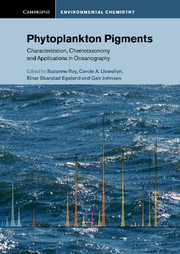Book contents
- Frontmatter
- Contents
- Contributors
- Preface
- Acknowledgements
- Abbreviations and symbols
- Part I Chlorophylls and carotenoids
- Part II Methodology guidance
- Part III Water-soluble ‘pigments’
- Part IV Selected pigment applications in oceanography
- Part V Future perspectives
- Part VI Aids for practical laboratory work
- Part VII Data sheets aiding identification of phytoplankton carotenoids and chlorophylls
- Index
- Plate Section
Preface
Published online by Cambridge University Press: 05 March 2012
- Frontmatter
- Contents
- Contributors
- Preface
- Acknowledgements
- Abbreviations and symbols
- Part I Chlorophylls and carotenoids
- Part II Methodology guidance
- Part III Water-soluble ‘pigments’
- Part IV Selected pigment applications in oceanography
- Part V Future perspectives
- Part VI Aids for practical laboratory work
- Part VII Data sheets aiding identification of phytoplankton carotenoids and chlorophylls
- Index
- Plate Section
Summary
Preface
In 1997, the Scientific Committee on Oceanic Research (SCOR) (with support from the United Nations Educational, Scientific and Cultural Organization (UNESCO) and the editors' institutions) sponsored a volume on phytoplankton pigments entitled Phytoplankton Pigments in Oceanography: Guidelines to Modern Methods. This volume was edited by Drs S. W. Jeffrey, R. F. C. Mantoura and S. W. Wright and resulted from the activities of SCOR Working Group 78. The 1997 volume went out of print a few years after publication (about 2000 copies were sold), which prompted UNESCO Publishing to print another 500 copies in 2005.
In April 2006, SCOR sponsored a workshop of pigment specialists from around the world to examine updates in this field. This workshop was hosted by Dr R. Fauzi C. Mantoura and the International Atomic Energy Agency's Marine Environmental Laboratory in Monaco. The updates that were identified include new advances in the taxonomy of marine phytoplankton (several new algal groups have been described since 1997), improved analytical techniques (notably HPLC-linked mass spectrometry, not generally used for pigment analysis before 1997), and new applications for pigments. The outcome of this meeting was a consensus that an update of the original 1997 volume was urgently needed, and a new editorial team was nominated. The present volume is the result of this update. Two of the three former editors of the 1997 volume contributed to the present volume (S. W. Jeffrey and S. W. Wright). Their collaboration ensures a smoother transition between the two volumes and prevents repetition, focusing instead on developments since the 1997 volume.
- Type
- Chapter
- Information
- Phytoplankton PigmentsCharacterization, Chemotaxonomy and Applications in Oceanography, pp. xxi - xxiiiPublisher: Cambridge University PressPrint publication year: 2011

